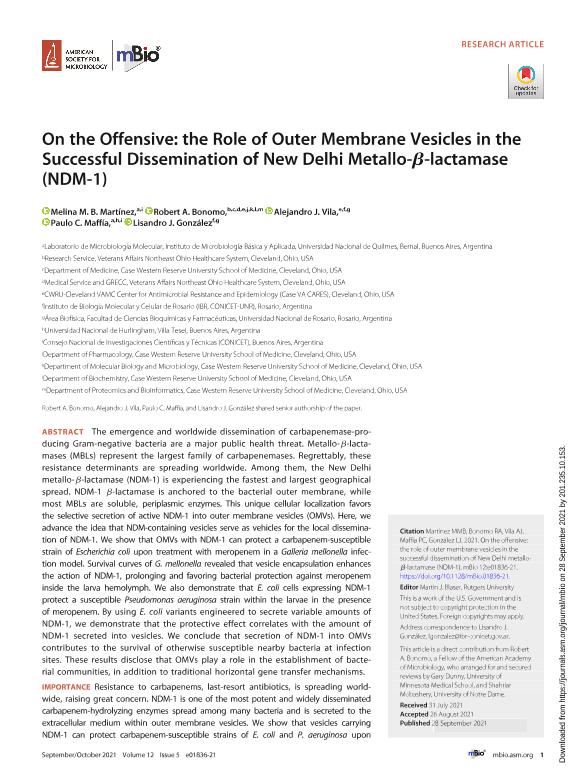Artículo
On the Offensive: The Role of Outer Membrane Vesicles in the Successful Dissemination of New Delhi Metallo-b-lactamase (NDM-1)
Martínez, Melina María Belén ; Bonomo, Robert A.; Vila, Alejandro Jose
; Bonomo, Robert A.; Vila, Alejandro Jose ; Maffia, Paulo Cesar
; Maffia, Paulo Cesar ; Gonzalez, Lisandro Javier
; Gonzalez, Lisandro Javier
 ; Bonomo, Robert A.; Vila, Alejandro Jose
; Bonomo, Robert A.; Vila, Alejandro Jose ; Maffia, Paulo Cesar
; Maffia, Paulo Cesar ; Gonzalez, Lisandro Javier
; Gonzalez, Lisandro Javier
Fecha de publicación:
10/2021
Editorial:
American Society for Microbiology
Revista:
MBio
e-ISSN:
2150-7511
Idioma:
Inglés
Tipo de recurso:
Artículo publicado
Clasificación temática:
Resumen
The emergence and worldwide dissemination of carbapenemase-producing Gram-negative bacteria are a major public health threat. Metallo-b-lactamases (MBLs) represent the largest family of carbapenemases. Regrettably, these resistance determinants are spreading worldwide. Among them, the New Delhi metallo-b-lactamase (NDM-1) is experiencing the fastest and largest geographical spread. NDM-1 b-lactamase is anchored to the bacterial outer membrane, while most MBLs are soluble, periplasmic enzymes. This unique cellular localization favors the selective secretion of active NDM-1 into outer membrane vesicles (OMVs). Here, we advance the idea that NDM-containing vesicles serve as vehicles for the local dissemination of NDM-1. We show that OMVs with NDM-1 can protect a carbapenem-susceptible strain of Escherichia coli upon treatment with meropenem in a Galleria mellonella infection model. Survival curves of G. mellonella revealed that vesicle encapsulation enhances the action of NDM-1, prolonging and favoring bacterial protection against meropenem inside the larva hemolymph. We also demonstrate that E. coli cells expressing NDM-1 protect a susceptible Pseudomonas aeruginosa strain within the larvae in the presence of meropenem. By using E. coli variants engineered to secrete variable amounts of NDM-1, we demonstrate that the protective effect correlates with the amount of NDM-1 secreted into vesicles. We conclude that secretion of NDM-1 into OMVs contributes to the survival of otherwise susceptible nearby bacteria at infection sites. These results disclose that OMVs play a role in the establishment of bacterial communities, in addition to traditional horizontal gene transfer mechanisms. IMPORTANCE Resistance to carbapenems, last-resort antibiotics, is spreading worldwide, raising great concern. NDM-1 is one of the most potent and widely disseminated carbapenem-hydrolyzing enzymes spread among many bacteria and is secreted to the extracellular medium within outer membrane vesicles. We show that vesicles carrying NDM-1 can protect carbapenem-susceptible strains of E. coli and P. aeruginosa upon treatment with meropenem in a live infection model. These vesicles act as nanoparticles that encapsulate and transport NDM-1, prolonging and favoring its action against meropenem inside a living organism. Secretion of NDM-1 into vesicles contributes to the survival of otherwise susceptible nearby bacteria at infection sites. We propose that vesicles play a role in the establishment of bacterial communities and the dissemination of antibiotic resistance, in addition to traditional horizontal gene transfer mechanisms.
Archivos asociados
Licencia
Identificadores
Colecciones
Articulos(IBR)
Articulos de INST.DE BIOLOGIA MOLECULAR Y CELULAR DE ROSARIO
Articulos de INST.DE BIOLOGIA MOLECULAR Y CELULAR DE ROSARIO
Citación
Martínez, Melina María Belén; Bonomo, Robert A.; Vila, Alejandro Jose; Maffia, Paulo Cesar; Gonzalez, Lisandro Javier; On the Offensive: The Role of Outer Membrane Vesicles in the Successful Dissemination of New Delhi Metallo-b-lactamase (NDM-1); American Society for Microbiology; MBio; 12; 5; 10-2021; 1-13
Compartir
Altmétricas



